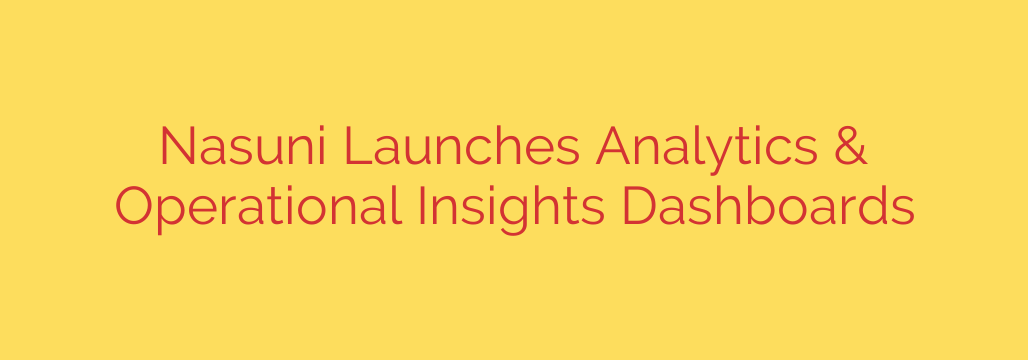
Unlocking Your Data’s Hidden Value: A New Era for Unstructured Data Analytics
Businesses today are sitting on a digital goldmine: vast, ever-growing volumes of unstructured data. This includes everything from documents, spreadsheets, and presentations to design files, images, and videos. While this information is critical for operations, it has historically been a black box, making it nearly impossible to analyze for deeper insights without complex, costly, and time-consuming processes.
The challenge is clear: How can you understand what’s inside your file data without moving it, duplicating it, or compromising its security? A groundbreaking new approach is changing the game, allowing organizations to gain unprecedented visibility into their file infrastructure for enhanced operations, security, and business intelligence.
The Challenge of Opaque File Data
For most IT leaders, managing massive amounts of unstructured data is a constant struggle. Key questions often go unanswered:
- How fast is our data actually growing, and where?
- Which files are being accessed most frequently, and by whom?
- How much of our expensive storage is being wasted on stale, unused data?
- Are there unusual access patterns that could signal a security threat like ransomware?
Without clear answers, organizations risk overspending on storage, experiencing performance bottlenecks, and missing critical security warnings. Traditional analytics solutions require extracting, transforming, and loading (ETL) this data into a separate warehouse—a slow, expensive, and insecure process that is simply not feasible for petabyte-scale environments.
A Modern Approach: Analyze Data In-Place
The future of data analytics lies in bringing the intelligence to the data, not the other way around. With the introduction of powerful new analytics connectors, businesses can now run queries directly on their file data where it lives. This revolutionary method allows you to connect your favorite business intelligence (BI) and analytics tools, such as Power BI, Tableau, or Snowflake, directly to your live file data ecosystem.
The primary advantage of this model is the elimination of complex and costly ETL pipelines. By analyzing data in-place, you avoid the security risks, administrative overhead, and significant expense associated with creating and maintaining duplicate data sets for analysis.
Gaining Critical Operational Insights for IT
For IT and infrastructure teams, this new level of visibility provides immediate, actionable intelligence. Pre-built operational dashboards offer a clear view into the health and usage of your entire file data environment.
Key benefits include:
- Optimize Storage and Reduce Costs: Easily identify cold or stale data that can be archived or tiered to cheaper object storage, freeing up valuable space on high-performance tiers and significantly lowering costs.
- Proactive Capacity Planning: Understand data growth trends across different departments, projects, and locations. This allows you to accurately forecast future storage needs and avoid unexpected capacity shortfalls.
- Enhance Performance and User Experience: Pinpoint which users, applications, or locations are generating the most traffic. This helps you diagnose performance issues and optimize resource allocation to ensure a smooth experience for all users.
- Strengthen Security and Compliance: Monitor file access patterns to detect unusual activity in real-time. See who is accessing, modifying, and deleting files to better enforce security policies and meet compliance mandates.
Actionable Security Through Data Awareness
Visibility into file usage isn’t just for operations—it’s a powerful security tool. When you can see exactly how your data is being used, you can spot threats before they escalate.
Here are three ways data analytics strengthens your security posture:
- Monitor for Ransomware Indicators: A common sign of a ransomware attack is a user account suddenly accessing and encrypting thousands of files in a short period. Analytics dashboards can flag this anomalous behavior immediately, allowing security teams to intervene and isolate the threat before it spreads.
- Enforce Data Governance: To comply with regulations like GDPR and CCPA, you need to know where your sensitive data is and who has access to it. Analytics provides a clear audit trail, helping you prove that access controls are being properly enforced.
- Identify Insider Threats: Whether malicious or accidental, insider threats are a major risk. By monitoring user activity, you can quickly identify when employees are accessing data that is outside their normal job function, enabling you to investigate and mitigate potential data leakage.
From IT Dashboards to True Business Intelligence
While operational insights provide immense value for IT, the true power of in-place analytics is its ability to unlock business intelligence. The same analytics connector that provides IT with performance metrics can be used by data analysts to query the content of the files themselves.
Imagine a marketing team analyzing sales reports from the past five years to spot seasonal trends, or a research firm running queries across thousands of project documents to identify patterns in their findings. This becomes possible when you can leverage the full power of your existing BI tools on your unstructured data, transforming a dormant corporate asset into a source of competitive advantage.
By finally shining a light on the “dark” unstructured data that drives your business, you can make smarter decisions, reduce risk, and uncover opportunities that were previously hidden from view.
Source: https://datacenternews.asia/story/nasuni-unveils-dashboards-for-analytics-operational-insights








